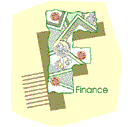A bond is a type of debt security, where the issuer owes the holders a debt and is obligated to pay the coupon rate and face value back, together with other obligations, stated in the terms.
 This is the technical definition of bonds. Here we will help you familiarize yourself with the terms used in this area of finance, such as face value, coupon rate and other, regularly used phrases.
This is the technical definition of bonds. Here we will help you familiarize yourself with the terms used in this area of finance, such as face value, coupon rate and other, regularly used phrases.
The basics
Bonds are typically issued by companies. They sort of act like a bank, because they use up your investment, and in return pay back interest (and also the face value).
The following are a list of definitions and terms we use to define the characteristics of a specific bond:
Par or face value: This is the actual amount of the debt. It is always given as a round number, in the US. It is usually $100 or $1000. The significance of the face value is that it will have to be payee back when the loaning period is over and that the coupon rate is set as a percentage of it.
Coupon rate: This is the interest that is payee each period. This period can be set, it is usually payee yearly, or every half year, but shorter periods are possible. The coupon rate is mostly a fix value, but the issuer can set it differently for each year, although it has to be set at the beginning.
Issue rate: This is price that the bond was issued at. This is usually close or equal to the face value, but in some cases there can be a few percent difference. If the issue rate is below the face value we say the issue was with a discount, if it is above the face value we say it was with a premium. This issue rate is the price for the primary market, meaning it is the price that the first buyers buy the bond. If the first buyer sells the bonds it is said that the he is selling on the secondary market.
Maturity: Maturity is the time when the total face value has been repaid. In developed economies, long term bonds can have a maturity of 20-30 years. If maturity is short, the face value is usually payee back at the end, in one amount. If maturity is long the face value is payee back in equal installments after a grace period.
Market value: This is also called theoretical value because it is not a real price, it is just used to show if buying a bond is worth it. It is the calculated present value of the bond’s cash-flows.
Current price: This is the price on the secondary market, the price that you would get if you sold your bonds.
In general there are three types of special bonds:
Puttable bonds: This is a right of the investors (who bought the bond) to ask for the repayment of the bond.
Convertible bonds: Also a right of the investors, to convert their bonds into different securities, like shares.
Callable bonds: This is a right of the issuer to repay the investor before maturity. Usually the time after issuers can recall their bonds is regulated by law.
Zero coupon bonds: These bonds do not have a coupon rate. They are issued well under their face value, and the amount repaid will be the face value. The profit is essentially a price difference gain.
We will not be looking at the special bonds (except zero coupon bonds) in terms of calculations, but we will make good use of the terms that define characteristics if the bonds. The best method is to familiarize yourself with the terms in general, and then solve some problems so you can really understand what they mean, there is no need to memorize them and then try starting problems.
Also note that there is a large variety of bonds out on the market. Due to monetary and financial innovations new types are emerging so we will be looking at basic examples, from which you can understand the underlying principals of the problems.